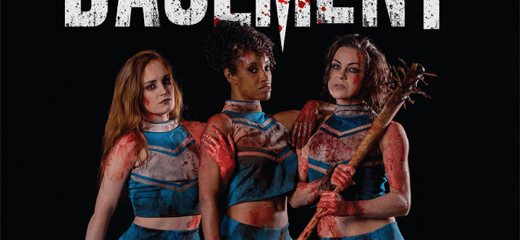
The Dark Side of Heartbreak
by Whitney Weinstein
BASEMENT has an alarmingly different tone than Gunnar Montana’s last show, KINK HAÜS, in 2017, and the athleticism and character development are utterly ineffable. With each flash of a strobe light, dancers thrash, whiplike, and twist around each other in ways I’ve never before witnessed. Exposed insulation, thick fog, and blood-stained floors characterize the closed-in space representing a murderer’s torture chamber. Warned of extreme gore, I also discover a man struggling to cope with a deeply complex love story.
The lights center on a woman whose extremities press into the outside edges of a freestanding bathtub. Arching her almost-naked body upward, she leans back to roll over the brim and spill into the tub, momentum propelling her to slide up the other side. In a post-show conversation, Montana explains to me, “I put the man in [the scene] watching because it’s something that he’s going through in his head. It’s intimate, like peeking through a [keyhole].”
A married couple, victim to toxic love saturated with dishonesty, find themselves trapped in a basement with a tormenter. Their choice: remaining captive together or one leaving alive. The wife defends herself against her husband’s assaults and escapes. The masked torturer, played by Montana, hangs the husband’s dead body from the ceiling, and then embraces it, cueing a flashback. A woman in a white dress and veil embraces the tormenter. She, with three other brides, swing around the overhead beams and each other, suspended from ceiling straps.
The killer gazes at his beloved, weakening at his knees. She looks ethereal, suspended above the man kneeling in the dirt of his sins. For the first time, I see heartbreak and vulnerability in the villain and, humanizing him, I empathize with his pain. Montana “thought about the scariest thing to work with: losing a loved one.”
The central character exposes masculinity through a domineering presence. “I wanted him to be dense and lethargic because of his internal conflicts. I have a lot of pent-up anger from everyday news. Here I get to overcome and express that. When I first made BASEMENT in 2013, women triumphing didn't matter in the world.” He explored what he calls the King Kong effect: creating a monster, then finding a way to feel sorry for him. “This character juggles being scary, defeated, sad, and still has control over the space.” In his self-created torture basement, the women, dressed as cheerleaders, are eventually able to overpower his terror and find a “cheering moment” in his defeat.
“It’s important to see that cinderblock switch, I call it, where she hits me in the end. There are political parallels. I feel like women made their movement overnight and became blood-thirsty cheerleaders. The switch of power in the show reflects that.”
Even through the violence, I see a man who yearns to recreate a meaningful time in his life. His wife reappears, caresses his face. They hold onto one another, each counterbalanced in a backwards hinge. In that moment, his misogyny temporarily dissipates.
Cast members quoted a recurring mantra throughout their process: “sometimes hurt people hurt people.” Montana reiterated, “This is not an hour of murdering women. It’s horror feminism. The girls triumph.”
BASEMENT, Gunnar Montana, The Latvian Society, 2019 Fringe Festival, September 5-8, 10-13, 14-15, 17-20, 21-22, 24-28.
By Whitney Weinstein
September 12, 2019









